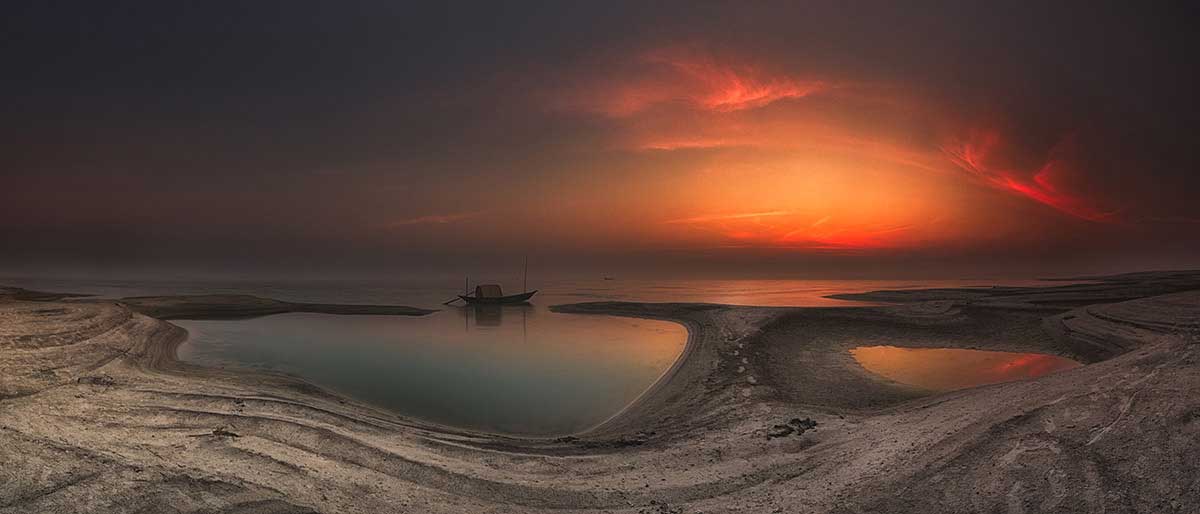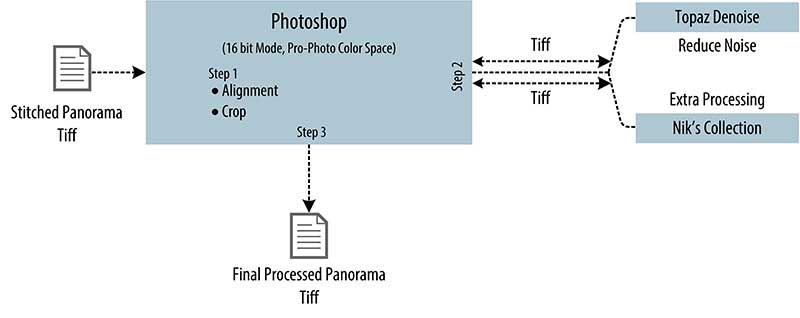Mohammad Rahman is a hobbyist Landscape photographer from Bangladesh, living in Australia. By profession, he is a software developer and a part-time Ph.D. student.
He loves to capture the variation of the light. The simple composition but in panoramic format is my passion. Through his photographs, the art seeker will explore the different dimension of the Bangladesh and its beauty of the riverscape.[Official Website] [Print Version] [Digital Version]
How did you get interested in photography?
We bought our first DSLR in 2013. It was Canon 60D with the 18-55m Kit lens. I remember, that time the DSLR was a complicated piece of equipment to me with all the mysterious settings. I had an extremely shallow understanding of aperture, ISO, shutter speed etc. I rarely take any photos, the camera was mostly unused.
One of the lazy mornings, in late 2013 I took the camera and went out in some of the remote villages in my hometown Rajbari in Bangladesh to take random photographs. I started loving it and gradually it became one of my passions.
What inspired you take your The Beauty at the River Series?
Bangladesh is my motherland which is one of the beautiful countries in the world. You will find friendly people, pleasing weather with six seasons, green forest and beautiful rivers over there.
I grew up in a small town which is surrounded by the mighty river the Padma. The river and the riverscape is always in my mind. The riverscape of Bangladesh tells the story about the natural beauty of Bangladesh. The mood, artistic appeal, loneliness, solitude, and tranquillity of the riverscape of Bangladesh, attract many art seekers to dive into the beauty of the Mother Nature. Since the beauty of the river and riverscape is noticeable, it always inspired me to take the opportunity to share it with the world.
How would you define your general style photography?
Simple Composition but in Panoramic format.
Could you please tell us anything about your technique and creating process?
Everyone has their own ways to achieve this objective. To me, this is a simple, systematic and symmetric process. It starts from location scouting and ends with producing the final image. Generally, I follow some steps in this process:
- Location Scouting
- Weather Forecast
- Capturing the Light: Light Balancing
- Tripod: Manage the Steadiness
- Exposure Selection
- Post processing workflow
Let’s talk about what I do in these steps.
Location Scouting
I usually look for the location beforehand and take lots of test shot using my mobile phone or 60D which I called preparation shot. I like this concept of the preparation shot. It helps me to understand the location better. It also helps me to analysis and research with the composition beforehand.
Weather Forecast
Weather is a critical element in any landscape photography. The weather forecast helps to find out the weather condition for example whether it is going to be cloudy/ foggy/ sunny/ rainy etc. and also information about the sunrise and sunset.
Another important bit is understanding the weather pattern of the location. I have found there is a cyclic weather pattern in the place I usually take photographs. The weather in this location has a periodic behavior which changes in a cycle of a wk. Say in any week one, I have started with a clear Blue sky as Figure 1 demonstrated then the following week two there will be the partly cloudy sky and then week after cloudy sky. In the following week four, the blue sky will appear again as Figure 1 demonstrated.
This cycle will continue to be the partly cloudy sky as the time goes by. During November to December winter will come and it will bring fog. In the foggy weather, there will be a different strategy.
I think understanding the weather helps a lot in the landscape photography. Research and experiment with the weather gives a positive outcome in the landscape photography.
Capturing the Light: Light Balancing
The light is the key to capture the awesome landscape and to capture it well, understanding the light is the key. In addition to the concept of the golden/blue hour, it’s also important to experience with different types of the light and find out a way to capture, for example, play with the harsh light in sunny noon, play with the soft diffused light in the winter foggy morning with the bright sun and also play with the sunrise and sunset. All these add up to capture the scenery well. On the other hand, for the panoramic capture, balanced light is must have otherwise panorama will not stitch properly.
In the panoramic world frame to frame balanced light is pre-requirement for smooth stitching experience. I prefer to apply the concept of the Standard Deviation over the measured exposure captured in AV mode to get balanced average light through the frames while taking the final images for the panorama in Manual mode. There is a trick I follow, say I am capturing panorama shots in the morning from the direction of right to left and the sun is on the right-hand side, in this circumstance I average the measured exposure (in AV mode) and reduce few stops from the measured average exposure while taking final shots in Manual mode as demonstrated in the Figure 2.
On the other hand, if I started capturing in the afternoon from the direction of left to right and the sun is on the left-hand side, I usually add few stops extra exposure to the measured (in AV mode) exposure while taking final shots in Manual mode as demonstrated in the Figure 3. By following this trick, I always get a well-exposed panorama.
Tripod: Manage the Steadiness
The balanced tripod is another challenge while taking multiple shots for a single panorama in the sandy bar. In the sandy bar the surface below the water is made with the soft sands that let the tripod leg easily go through which caused the instable tripod. But in panoramic capture balanced tripod is critical. To eliminate the stability issue I use 12×6 inch 3 wooden bar to put underneath the tripod leg to keep it balanced.
In the panoramic photography, Parallax Effect is one of the common issues. I use Nodal Ninja pano head to address this issue. In addition, on some occasions, I take more shots instead of using pano head when there is a steady light condition, for example, the cloudy sky with the sun behind and not strong wind around or in the deep foggy day.
Exposure Selection
I like long exposure panorama. My preferable exposure is in between 3 to 6 seconds which gives a balanced light, smooth water if there are any tide and beautiful surreal sky. I try to avoid any exposure above the 6 seconds because with this exposure it becomes difficult to stitch. Although the ideal exposure time varies depending on the situation, that needs to figure out based on the circumstance.
Post processing workflow
I follow a standard workflow to do the pano post-processing as demonstrates by the below diagram:
From the above Figure we can see the workflow has following steps:
- Conversion
- Stitching
- Post-Processing
If you look in brief of these:
Conversion
I capture in RAW. I convert the raw file (in canon world CR2) into Tiff file format. I use Lightroom tool and prefer 16bit Pro-Photo color space for conversion.
Stitching
I use the converted Tiff files to stitch to generate the panorama. There are many tools to do so. I prefer PtGui to stitch. In the PtGui, I use Smart Blend plugin to blend and for the final stitched panorama, I use 16bit Pro-Photo color space and 16bit Tiff.
Post-Processing
This is another mystery world, many people have many views on it. I usually follow: in
- Step 1: Alignment, Crop
- Step 2: Reduce noise, sharpening, and extra processing, if it requires and in
- Step 3: Generating the final processed panorama
As demonstrated in the Figure 5 below:
I use Adobe Photoshop to do the post-processing as demonstrated in Figure 5 and I love Google Nik’s collection.
In your opinion, what makes a good landscape photography?
Location, light and artistic mind with patience, enthusiasm, and love for the nature.
How much preparation do you put into taking a photograph?
A good preparation with dedication is key for the successful photography project. Last 4 years, I am doing this riverscape photography and each year with different ideas, planning, preparation and dedication with the simple but concrete process.
The process started every morning, we woke up early in the morning around 4.00AM. We finished our early morning breakfast and set off to the river. The boatman was waiting for us in the boat and as soon as we were in, he set off the boat to the Sandy Bar (Char). It took about 25minutes by boat to be there and by 5.30AM we were in the location. There were still dark but gave us enough time to setup: setup the tent, set up the tripod, find out the spot to shot, put the camera on, plug the remote release and put on the filter ring with necessary filters.
The sun raised around 6.30AM but by 6 AM we got fantastic light (depending on the weather) and start shotting.
What do you think makes a memorable project?
Make fun, make mistake, learn from mistake and enjoy the nature. Take notes, review it and apply your learnings in the field. If you see my scraps book it’s full of notes that roughly looks below:
- Exposure selection was wrong
- More careful about my gear
- I should use long expo
- The boat position wasn’t correct
- Cloud formation wasn’t very good; wait for another day and so on
How do you know you got the shot you wanted?
Few things I check:
- Whether it is well exposed via Histogram.
- Enough shots to stitch
Your idea of the perfect composition
It is a variable. The artist always seeks for something different, something new. But what I think about the perfect composition is the composition which gives relaxation to your eyes, peace in your mind and something to tickle your brain to make you think.
What would I find in your camera bag or Studio?
All the below in the Lowepro Flipside 500 AW II
- Canon 6d
- Canon 60d
- Canon EF 16-35mm f4 L IS USM
- Canon EF-S 10-18mm f/4.5-5.6 IS STM Lens
- Sigma 70-300mm f4-5.6 DG Macro Lenses (Canon)
- LEE 6 Stop ND Filter
- LEE 10 Stop ND Filter
- LEE 3 Stop GND Filter
- LEE Adapter Rings
- NN4 w/RD16-II Advanced Rotator (F4503)
- Manfrotto 190XDB + 804RC2 Tripod
- Remote Shutter Release
- Rocket Blower
- SanDisk Extreme 16GB SDHC Card 45mb/s
- Cleaning Kit
- Camera Rain Coat
- Energizer 2A/3A Batteries
How important is an awesome website for your business and how has social media played a role in your photography?
It is really important.
What future plans do you have? What projects would you like to accomplish?
I love rivers, so I think I will keep doing this but off course with different ideas. I have a plan to do aerial riverscape photography.
Finally, one las question. What opinion do you have of Dodho Magazine and Life in Color 2017?
I really like the way Dodho collaborate with the world wide photographer, it is fantastic.













